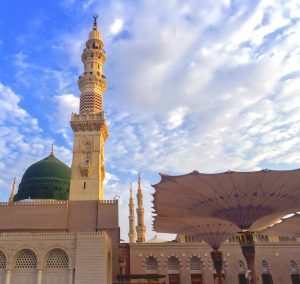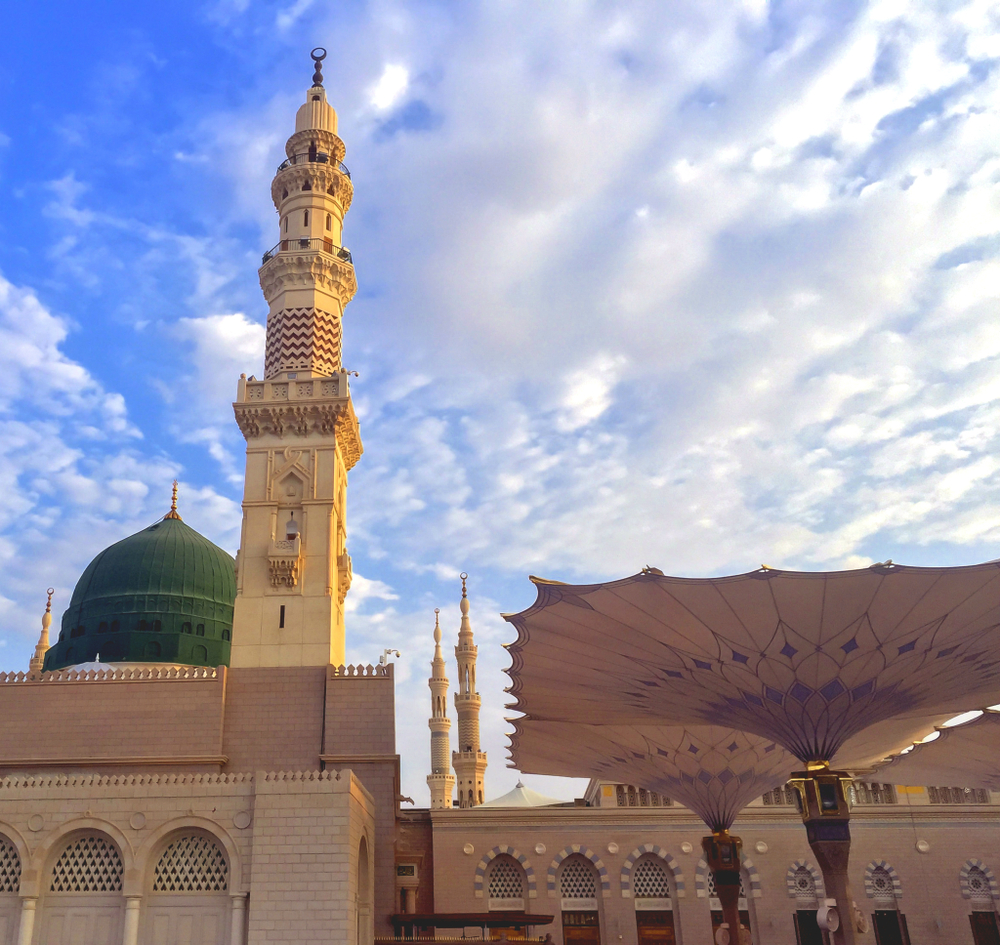By Khurram Murad

More and more people over the course of a year – tribal leaders, men and women – in Yathrib became Muslims.
The Message that Makkah and Taif rejected, found responsive hearts in Yathrib, a small oasis about 400 kilometres to the north of Makkah. Now known as Madinatun Nabi, the city of the Prophet, or Al-Madinah Al-Munawwarah, the radiant city, it was destined to be the centre of the Divine light that was to spread to all parts of the world for all times to come.
In quick succession, the Prophet (peace be upon him) suffered the terrible loss of Khadijah, his intimate and beloved companion for 25 years, and of Abu Talib, his guardian and protector against the bloodthirsty Makkan foes, and encountered the worst ever rejection, humiliation and persecution at nearby Taif.
As the Prophet reached the lowest point in his vocation, God brought him comfort and solace. On the one hand, spiritually, He took him during the Night of the Ascension to the highest of highs, realities and divinities, face to face with the Unseen.
And on the other, materially, he opened the hearts of the people of Yathrib to the Message and mission of Muhammad. Soon after Muhammad’s return from Taif and the Night Journey, at the time of the Pilgrimage, six men from Yathrib embraced Islam.
They delivered the Message of Islam to as many as they could, and at the time of the next Pilgrimage in the year 621 CE, 12 persons came. They pledged themselves to the Prophet, that they would make no god beside God, that they would neither steal nor commit fornication, nor slay their infants, nor utter slanders, nor disobey him in that which is right.
The Prophet said: ‘If you fulfil this pledge, then Paradise is yours.’ This time the Prophet sent Mus`ab ibn `Umayr with them to teach them the Quran and Islam and to spread the Message of Islam.
More and more people over the course of a year – tribal leaders, men and women – in Yathrib became Muslims. At the time of the next Pilgrimage, they decided to send a delegation to the Prophet, make a pledge to him, and invite him and all Muslims in Makkah to Yathrib as a sanctuary and as a base for spreading the Divine Message of Islam. In all 73 men and two women came. They met the Prophet at [Aqabah.
They pledged to protect the Prophet as they would protect their own women and children, and to fight against all men, red and black, even if their nobles were killed and they suffered the loss of all their possessions.
When asked what would be theirs if they fulfilled their pledge, the Prophet said: ‘Paradise’. Thus, the beginning was made, the foundations of the Islamic society, state and civilization were set. The road was now open for the persecuted and tortured followers of the Prophet to come to the House of Islam, that was to be Madinah. He, therefore, instructed them to emigrate, and gradually most of them found their way to Yathrib.
Their Makkan foes could not bear to see the Muslims living in peace. They knew the power of the Prophet’s Message, they knew the strength of those dedicated believers who cared nothing for the age-old Arab customs and ties of kinship, and who if they had to would fight for their faith.
The Makkans sensed the danger that the Muslims’ presence in Madinah posed for their northern trade caravan routes. They saw no other way to stop all this but to kill the Prophet. Hence they hatched a conspiracy: one strong and well-connected young man was to be nominated by each clan, and all of them were to pounce upon and kill the Prophet one morning as he came out of his house, so that his blood would be on all the clans’ hands.
Thus, the Prophet’s clan would have to accept blood-money in place of revenge. Informed of the plot by the Angel Gabriel, and instructed to leave Makkah for Madinah, the Prophet went to Abu Bakr’s house to finalize the travel arrangements.
Abu Bakr was overjoyed at having been chosen for the honour and blessing of being the Prophet’s Companion on this blessed and momentous, sacred and epoch-making journey. He offered his she-camel to the Prophet, but the Prophet insisted on paying its price.
On the fateful night, as darkness fell, the youths selected by the Quraish leaders to kill the Prophet surrounded his house. They decided to pounce on him when he came out of his house for the dawn Prayers.
Meanwhile, the Prophet handed over all the money left by the Makkans with him for safe keeping to Ali. Ali offered to lie in the Prophet’s bed.
The Prophet slipped out of his house, threw a little dust in their direction, and walked past his enemies, whose eyes were still on the house. He met Abu Bakr at his house, and they both travelled to a nearby cave, the Jabal Thawr.
When the Quraish realized that the Prophet had evaded them, they were furious. They looked for him everywhere and on all roads; they also offered a reward of 100 she-camels for anybody who would bring them the Prophet, dead or alive.
A tribal chief, Suraqa, sighted the Prophet and followed him, hoping to earn the reward. The Prophet, with bloodthirsty foes in pursuit and an uncertain future ahead of him in Madinah, told Suraqa: ‘A day will soon come when Kisra’s golden hand bracelet will be in Suraqa’s hands.’
Thereafter, Suraqa retreated, and the Prophet proceeded towards Madinah. This was Hijrah, the emigration – a small distance in space, a mighty leap in history, an event that was to become a threshold in the shaping of the Islamic Ummah.
This is why the Muslims date their calendar from Hijrah, and not from Hira or from the birth of the Prophet.
In Qubah, 10 kilometres outside Madinah, the Prophet made his first sojourn. Here he built the first mosque. Here he also made his first public address: ‘Spread peace among yourselves, give away food to the needy, pray while people sleep – and you enter Paradise, the house of peace.’ Three days later, the Prophet entered Madinah.
Men, women, children, the entire populace came out on the streets and jubilantly welcomed him. Never was there a day of greater rejoicing and happiness. ‘Come is the Prophet! Come is the Prophet!’, sang the little children.
The first thing the Prophet did after arriving in Madinah was to weld the Emigrants (called Muhajirs) and the hosts, called the Helpers (or Ansar) into one brotherhood. Still today this brotherhood remains the hallmark of the Muslims.
One person from the Emigrants was made the brother of one from amongst the Helpers. The Helpers offered to share equally all that they possessed with the Emigrants. So the Muslims were forged into a close-knit community of faith and brotherhood, and the structure of their society and polity was being built.
The first structure was also raised. This was the Mosque, or Masjid, the building consecrated to the worship of One God – called Al-Masjid al-Nabawi, the Prophet’s Mosque.
Since then the Masjid has also remained the hallmark of the Muslims’ collective and social life, the convenient space for the integration of the religious and political dimensions of Islam, a source of identification, a witness to Muslim existence.
At the same time, steps were taken and the required institutions built to integrate the entire social life around the centre and pivot of the worship of One God.
For this purpose, five daily Prayers in congregation were established. Ramadan, fasting every day from dawn to sunset for an entire month, was also prescribed. Similarly, to establish ‘giving’ as the way of life, zakah, a percentage of one’s wealth to be given in the way of God, was made obligatory.
As long as there was no different instruction from God, the Muslims followed the practices observed by the Jews and Christians. Hence, they used to pray with their faces turned towards Jerusalem.
But soon this direction to which the Muslims faced in Prayer was changed from Jerusalem to Makkah. This historic episode signalled the formation of a new Muslim community, charged with Divine trust and the mission of God’s guidance, replacing the earlier Jews and Christians, and following the most ancient message of Abraham, turning towards the most ancient House of God, built by him.
Source: Taken from the author’s Who Is Muhammad? Published by Islamic Foundation, London, 1998.
Read also:
Who Is Muhammad? (Part 1) Early Life in Makkah
Who Is Muhammad? (Part 2) The Prophet at Makkah
[opic_orginalurl]


